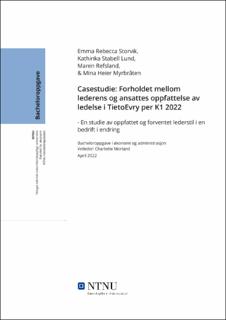| dc.contributor.advisor | Morland, Charlotte | |
| dc.contributor.author | Lund, Kathinka Stabell | |
| dc.contributor.author | Myrbråten, Mina Heier | |
| dc.contributor.author | Refsland, Maren | |
| dc.contributor.author | Storvik, Emma Rebecca | |
| dc.date.accessioned | 2022-06-23T17:19:46Z | |
| dc.date.available | 2022-06-23T17:19:46Z | |
| dc.date.issued | 2022 | |
| dc.identifier | no.ntnu:inspera:108383376:110653970 | |
| dc.identifier.uri | https://hdl.handle.net/11250/3000393 | |
| dc.description.abstract | I løpet av semesteret har gruppen bearbeidet data med målet om å svare på problemstillingen “Hvordan oppfatter leder og ansatte i TietoEvry lederens lederstil, sammenlignet med de ansattes forventninger til lederen i endringssituasjonen?’’
For å besvare problemstillingen har vi tatt utgangspunkt i teorier knyttet til lederstil i ulike situasjoner, samt leder-medarbeider relasjonen. Disse teoriene har gitt oss et bilde av lederen, og hvordan de ansatte ser på sin leder. Dette danner grunnlaget for å kunne svare på vår problemstilling da vi kan knytte faktiske hendelser opp mot relevante teorier.
Resultatene våre indikerte at leder ser på seg selv som en delegerende leder, mens de ansatte i større grad ønsket seg at leder skulle ha en mer deltakende rolle. Lederen hadde videre en forventning om å bli oppfattet som uklar, noe som er motstridende til hva de ansatte oppfattet lederen som. Delkonklusjonen blir her at det eksisterer ulike oppfatninger av lederens lederstil. Før vi startet med analysen forventet vi at lederes oppfatninger om egen lederstil skulle stemme.
Tillit er en sentral del av forholdet mellom leder og ansatt. Dette danner et viktig grunnlag for å etablere høy leder-medarbeider-utveksling i fremtiden. Til tross for at relasjonen er i et tidlig stadium, ser vi tydelig at alle ser på tillit som en sentral faktor for den profesjonelle relasjonen.
I en endringssituasjon er personlige egenskaper ved leder vel så sentrale som hva leder faktisk gjør. Om en leder er godt egnet til å lede endring i en organisasjon sier mye om hvordan utfallet blir. Delkonklusjonen vår her er at lederen har karismatiske personlighetstrekk og passer derfor godt til å lede tidlige faser av endringsprosesser. Karismatiske ledere har egenskapen til å motivere ansatte til å bli med på endring. | |
| dc.description.abstract | Throughout this semester we have collected and analyzed data with the purpose of answering our study question: “How does the leader and employees of TietoEvry perceive the leader’s leadership style, compared to the employees’ expectations of the leader during change situations?”.
To be able to answer this issue we evaluated all of the answers we got compared to a chosen set of theories. We used theories related to leadership style in different situations, as well as the leader-employee relationship. These theories have given us a perception of the leader, and how the employees view their leader. This forms the basis for being able to answer our study question as we can link actual events to relevant theories.
Our results indicated that the leader sees themselves as a delegating leader, while the others wanted the leader to take a more participating role. The leader also had an expectation of being perceived as unclear, which is contrary to what the employees perceived the leader as. However, the interviews showed that this is the opposite of what the employees indicated. Our sub-conclusion for this part is that there are different perceptions of the leader’s leadership style. Before we started with the analysis, we expected the leaders’ perceptions of their own leadership style to be correct.
Trust is an important asset in the relationship between leader and employee. This is an important part for establishing a high leader-employee-exchange in the future. Even though the relationship is at an early stage are we seeing clear signs of trust being an important part of their professional relationships.
Furthermore, in a changing situation the personal sides of the leader are important one. How a person is fit to change an organization is important for the outcome. Our sub-conclusion for this part is that the leader is charismatic, and therefore well suited to be in charge in the early stages of the process due to the abilities to include people and to be the source of motivation. | |
| dc.language | nob | |
| dc.publisher | NTNU | |
| dc.title | Casestudie: Forholdet mellom lederens og ansattes oppfattelse av ledelse i TietoEvry per K1 2022
- En studie av oppfattet og forventet lederstil i en bedrift i endring | |
| dc.type | Bachelor thesis | |
